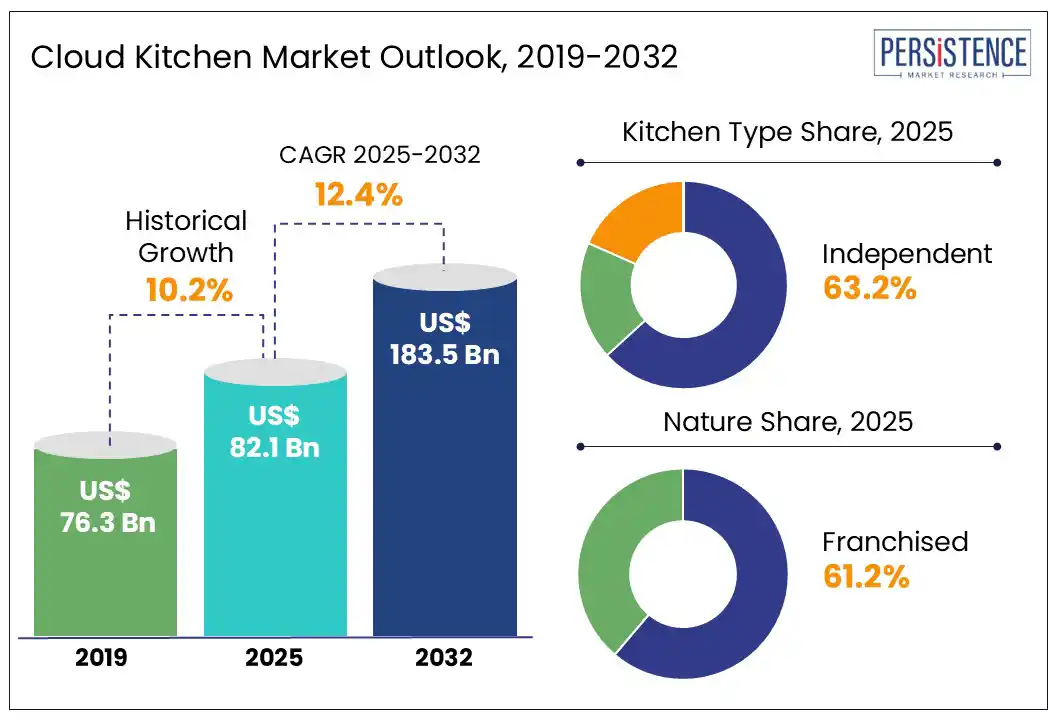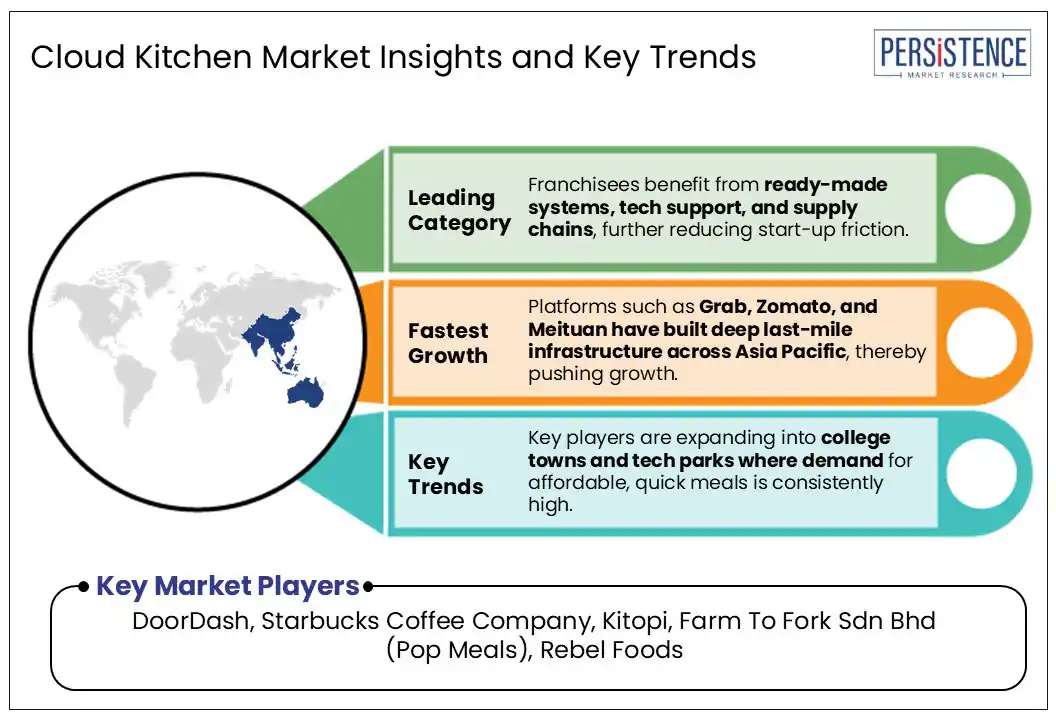ID: PMRREP35478| 197 Pages | 11 Jul 2025 | Format: PDF, Excel, PPT* | Food and Beverages

The cloud kitchen market size is likely to be valued at US$ 82.1 Bn in 2025 and is expected to reach US$ 183.5 Bn in 2032, growing at a CAGR of 12.4% during the forecast period 2025-2032.
The cloud kitchen market has rapidly evolved into a transformative force within the global food and beverage industry. Defined by kitchens operating exclusively for delivery without storefronts, wait staff, or dine-in facilities, cloud kitchens prioritize operational efficiency, scalability, and data-driven decision-making, fundamentally reshaping traditional restaurant economics. This business model leverages technological innovation and the growing demand for online food delivery, enabling operators to reduce overhead costs while expanding market reach.
The key trends fueling this expansion include the rise of virtual brands, multi-concept kitchens, integration of AI and data analytics for operational optimization, and diversification of delivery channels. The cloud kitchen sector’s ability to adapt rapidly to consumer demands and technological advancements positions it as a pivotal growth segment within the global foodservice market.

Key Industry Highlights
|
Global Market Attribute |
Key Insights |
|
Cloud Kitchen Market Size (2025E) |
US$ 82.1 Bn |
|
Market Value Forecast (2032F) |
US$ 183.5 Bn |
|
Projected Growth (CAGR 2025 to 2032) |
12.4% |
|
Historical Market Growth (CAGR 2019 to 2024) |
10.2% |
Increasing demand for convenient dining options, fueled by the normalization of app-based food ordering, is accelerating the cloud kitchen market growth. Cloud kitchens are built entirely around delivery logistics, enabling quick meal preparation and optimized packaging suited for transit. According to a 2024 online survey, 67% of urban millennials in Asia Pacific now order food at least 4 times a week, with 40% citing lack of time to cook as their primary reason. This shift toward convenience has made delivery-first brands not only viable but essential in urban food ecosystems.
Leading delivery platforms have also contributed to this trend by offering tools that enhance the ordering experience. Features such as predictive ETA, dynamic menu pricing, and subscription discounts have helped in lowering the friction between craving and consumption. In response, cloud kitchens have developed their menus to suit short prep times, travel resilience, and repeatability. For example, Indonesia’s Dailybox optimizes its menu around rice-based bowl meals that can be prepared in under seven minutes and remain fresh for over 40 minutes in transit. This strategy helps in meeting both speed and quality expectations.
The absence of physical storefronts makes it inherently difficult for cloud kitchens to build lasting brand recognition. This directly impacts their customer retention and long-term scalability. Without a walk-in presence or street-level visibility, these virtual brands rely almost entirely on aggregator platforms and digital marketing for discovery. This reliance on food delivery apps creates a discovery bottleneck, wherein new or niche brands struggle to stand out unless they pay for sponsored visibility.
Consumer trust in virtual-only brands remains fragile, mainly when issues around food quality or packaging arise. Cloud kitchens have a single transactional touchpoint, usually mediated by a delivery partner, limiting their ability to fix negative experiences. This lack of emotional brand connection hampers word-of-mouth growth.
The occasion-based eating trend is creating significant opportunities for cloud kitchens by allowing them to develop targeted, time-specific menus. Instead of relying solely on lunch or dinner volumes, they are now catering to breakfast, mid-day snacking, post-gym meals, late-night cravings, and even celebration-oriented micro-events. This granular segmentation lets kitchens repurpose infrastructure throughout the day, increasing order volume without expanding physical footprint. India’s EatFit, for instance, launched dedicated breakfast and protein-snack menus aimed at health-conscious consumers ordering before 10 AM or post-7 PM.
Cloud kitchens are also using data analytics to identify underserved time slots and develop virtual brands accordingly. In the U.K., Karma Kitchen launched a series of late-night dessert-only brands, after identifying a gap in post-10 PM delivery demand. These brands operated exclusively between 9 PM and 2 AM, achieving 1.8x higher order volumes than their all-day brands during the same window. Similarly, in South Korea, Baedal Minjok (Baemin) partnered with local operators to launch breakfast bento and post-drinks porridge concepts that cater to culturally specific consumption times.
By kitchen type, the market is trifurcated into independent kitchen, commissary/shared kitchen, and kitchen pods. Among these, independent kitchens are expected to hold nearly 63.2% of the cloud kitchen market share in 2025 owing to their ability to respond quickly to hyperlocal food trends without being tied to legacy systems or large organizational overheads. These small-scale operators often focus on niche cuisines, specialty diets, or regional favorites, allowing them to stand out in a saturated delivery ecosystem. In India, for example, independent brands such as Goila Butter Chicken and Biryani By Kilo have developed loyal customer bases by delivering tightly curated menus and maintaining a distinct culinary identity.
Commissary/shared kitchens are also anticipated to see steady growth through 2032 due to their role in drastically lowering the entry barrier for food entrepreneurs as well as small food and beverage brands. By offering ready-to-use infrastructure such as kitchen space and smart kitchen appliances, these facilities eliminate the requirement for heavy upfront investments. This model has enabled the rapid proliferation of local food brands, especially in high-rent urban areas where independent restaurant ownership is cost-prohibitive. In cities such as Los Angeles, for example, the average setup cost of a conventional restaurant can exceed US$250,000. However, a slot in a shared kitchen can be leased for as little as US$1,500 per month, including utilities and basic staff support.
In terms of nature, the market is bifurcated into franchised and standalone. Out of these, the franchised segment will likely account for about 61.2% share in 2025 as they provide a low-risk, asset-light route to brand expansion while ensuring operational consistency and scalability. Established food brands use the franchise model to rapidly penetrate new geographies without direct capital investment. Rebel Foods, for instance, has successfully franchised several of its brands, such as Oven Story and Faasos, to kitchen partners across India and the Middle East.
Standalone cloud kitchens are gaining prominence due to their ability to build hyperlocal brand identity without being tied to the complex operations of multi-brand models. These operators retain complete control over menu, pricing, branding, and customer interaction, which allows them to differentiate through originality and responsiveness. The Momo Co. in India, for instance, has grown purely as a standalone delivery-first brand, focusing exclusively on regional dumpling variations and customizing offerings by city. This helped it achieve a 3x increase in repeat customers between 2022 and 2024.

In North America, the market has shifted from explosive pandemic-era growth to a phase of strategic consolidation and recalibration. Leading players have scaled back or restructured operations due to unsustainable real estate costs and operational inefficiencies.
For instance, Kitchen United, sold its software platform to Zuul Kitchens in 2024 and closed multiple locations after struggling to maintain profitability. Similarly, CloudKitchens faced lawsuits and public scrutiny over aggressive lease agreements and operational opacity, prompting a slowdown in expansion.
Despite these challenges, the U.S. cloud kitchen market continues to attract investment in specialized niches. In 2023, Popchew, a New York-based cloud kitchen start-up, focused on creator-led food brands. It raised fresh capital to extend its influencer-partnered menus. This reflects a surging trend in the U.S. toward leveraging digital personalities to drive traffic to delivery-only brands. Another example is Local Kitchens, a micro food hall model that operates from physical spaces but functions such as a cloud kitchen by aggregating multiple brands in suburban areas.
Europe has entered a phase of cautious maturity after the boom triggered by the pandemic. Key markets such as the U.K., Germany, and France have seen saturation in core urban areas. It has prompted operators to either consolidate or expand into tier-2 cities. Deliveroo Editions, one of the earliest players in the U.K., has been downsizing its dedicated cloud kitchen spaces since late 2023. It has shifted focus toward more hybrid models, including host kitchens, where existing restaurants cook for multiple virtual brands under one roof. This move highlights increasing operational costs, tightening delivery regulations, and changing consumer behavior toward dine-in preferences.
France’s Taster, a significant virtual restaurant group, recently raised around €8 Mn to develop technology that optimizes kitchen efficiency and reduces delivery waste, showcasing a regional trend toward sustainability and automation. In Germany, Keatz shut down several of its outlets after failing to maintain profitability, indicating that consumers demand more transparency in brand identity and food origin, which anonymous delivery-only brands often lack. In addition, EU norms around food safety, data privacy, and employment laws are more stringent compared to North America, making scaling harder for low-margin, high-volume models.
In 2025, Asia Pacific is estimated to account for approximately 48.5% share due to urban congestion, high mobile penetration, and surging food delivery demand. India remains one of the most dynamic markets with companies such as Rebel Foods scaling via a multi-brand cloud kitchen strategy. By 2024, Rebel had expanded to over 600 kitchens across more than 70 cities and entered partnerships with international chains, including Wendy’s and Kitopi. Its operating system, which combines AI-backed demand mapping with vertical supply chain control, has become a blueprint for other companies looking to scale efficiently.
Singapore and Indonesia are also emerging as innovation hubs. For instance, Smart City Kitchens in Singapore has adopted a plug-and-play kitchen leasing model. It offers real-time analytics and flexible tenancy to restaurant operators, helping reduce capex and time to market. It reported a 3x surge in tenant retention by late 2023 due to its data-driven approach and focus on premium locations near residential clusters. In Indonesia, Hangry has successfully merged cloud kitchens with dine-in concepts, operating over 80 outlets by early 2025. Its hybrid strategy responds to local consumer preferences for both online convenience and offline trust-building.
The cloud kitchen market is characterized by constant expansion by food aggregators, rapid scaling by multi-brand virtual kitchen start-ups, and strategic collaborations with restaurant chains. Key players have adopted asset-light models, leveraging data analytics and AI for demand forecasting and menu optimization. Delivery platforms are increasingly venturing into their own kitchen infrastructure. They are doing so either through partnerships or by providing kitchen spaces to restaurant brands. This dual role of aggregator and infrastructure provider creates a vertically integrated ecosystem that small standalone cloud kitchens struggle to compete with.
The cloud kitchen market is projected to reach US$ 82.1 Bn in 2025.
High real-estate costs, and urban lifestyles are the key market drivers.
The cloud kitchen market is poised to witness a CAGR of 12.4% from 2025 to 2032.
The emergence of occasion-based virtual brands and the integration of AI for demand forecasting are the key market opportunities.
DoorDash, Starbucks Coffee Company, and Kitopi are a few key market players.
|
Report Attribute |
Details |
|
Historical Data/Actuals |
2019 - 2024 |
|
Forecast Period |
2025 - 2032 |
|
Market Analysis Units |
Value: US$ Bn/Mn, Volume: As Applicable |
|
Geographical Coverage |
|
|
Segmental Coverage |
|
|
Competitive Analysis |
|
|
Report Highlights |
|
|
Customization and Pricing |
Available upon request |
By Kitchen Type
By Nature
By Product
By Solution
By Region
Delivery Timelines
For more information on this report and its delivery timelines please get in touch with our sales team.
About Author